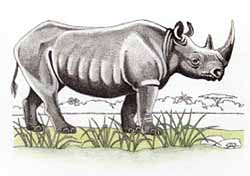English: Black Rhinoceros; French: Rhinocéros noir; Acholi: Amuku; Afrikaans: Swartrenoster; Amharic: Aurarissi; Arabic: Abugern; Damara: !nabas, !nu; Hausa: Karkanda; Herero: Ongava; Iswana: Ishukudu; Kikuyu: huria; Kirundu: inkura; Kiswahili: Faru; Kun g: N!a; Kwanyama: Omhanda; Lozi: Sembele; Lugunda: Enhula; Maasai: emuny; Ndorobo: Munyi, Nyiee; Owambo: Ominda; Peulh: Safe Na; Sechuana: Borele, Keitloa; Sesuto: Upelepi; Shangan: Xibedjane; Shona: Chimpembere, nhema; Sindebele: Bhejane; Somali: Wil; Tswana: Kgêtlwa, Kôbaôba; Xhosa: Umkhombe; Zulu: Ubhejane, Isibhejane.
 |
Former distribution: From the Sudan to Ethiopia, Somalia, Kenya, the Central African Republic, Zaire, Uganda, Tanzania, south to Zambia, Mozambique, Malawi, Zimbabwe, Botswana, Angola and South Africa, Cameroon, Chad and Nigeria.
Present distribution: As formerly, but in most of the countries indicated, only small populations remain – mostly in national parks and game reserves.
Behaviour: Preferred habitat: see Breitmaulnashorn. The Black Rhinoceros is a browser: diet includes leaves from bushes and scrub. Dry forests up to rain forests: predators of the pups are hyenas and lions.
Population status: Endangered. Total: 3-4000 estimated.
Brief notes:
Body weight: 900-1600 kg
Head and body length: 280-360 cm
Tail length: 60-70 cm
Shoulder height: 140-225 cm
Gestation period: 15 months
Maximum age: Up to 40 years
Trophy: Horn length. Record RW’s: 114 7/8″, Tanzania, Game Dept. Arusha; average 70″. SCI: 89 4/8″, 1955 Kenya, C. CALDESI; average 60″.
Hunting methods: Formerly by stalking and on horseback; now everywhere protected by law.
Remarks: It is anticipated that the drastic decline of the Black Rhinoceros populations will continue. Poaching for its horns, and habitat destruction due to the enormous increase of human populations, as well as the destruction of forests by elephants also play a significant part in the threats to the survival of these animals. The best protection they have remains in well managed national parks and game reserves.





